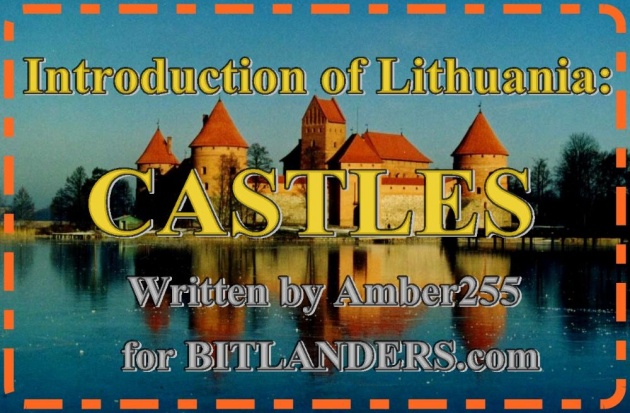
Introduction of Lithuania: Most Famous Lithuanian Castles - Photo credit: Amber255 via Bitlanders.com
Greetings! I know that my country, Lithuania, is too small compared with some other countries, and tourism is not enough developed here, but still, every year we have the increased numbers of tourists. We also have an increased number of cruise ships coming to our country. So, I want to introduce you my lovely small but not less beautiful country that I love very much. I think I will write a few blogs about the introduction of Lithuania to those who may know nothing about this little country, or to those who search info before coming there. We really can to show you some great and beautiful places. I am starting from the ancient castles, the most beautiful Lithuanian castles that still stay and enchant its visitors. Why do I start from the castles? Because I am a bit crazy about everything that is old, ancient and smelts the history.
It's a pity, but some of our ancient castles, built by our dukes, later, when there were changed the borders of Lithuania, went to Belarus, and now those ancient castles enchant citizens of stranger country.
Lithuanian castles - Video credit: dzonisbrawo2 via Youtube.com
I offer you to look at and get familiar with the most famous Lithuanian castles, survived castles of the Grand Duchy of Lithuania. I will not dig too deep into the history of those castles, as the history is may more important to our citizens, not to strangers. I just shortly describe them, and you will decide is it interesting to you or not. I want to note that our ancient castles are one of the famous tourist attractions in Lithuania.
Gediminas Castle Tower
Gediminas Castle Tower is the remains of the Upper Castle of Vilnius. All Lithuanians know the legend about the Gediminas Castle built by the Grand Duke of Lithuania Gediminas which led to the founding of Vilnius in the 14th century. After archaeological excavations, traces of the Neolithic population were discovered in the current Gediminas Castle Hill.
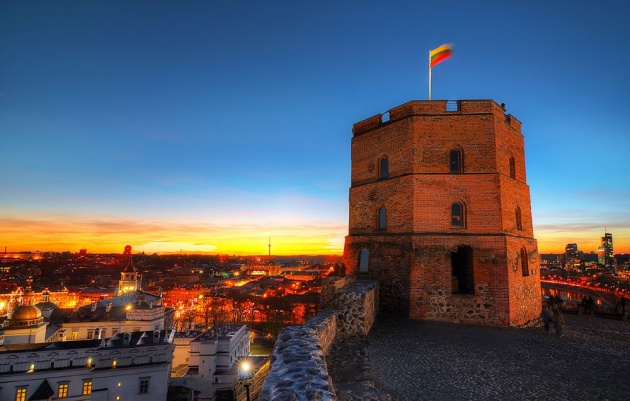
Gediminas Castle in Vilnius - Photo credit: efoto.lt
Time ago, there was a wooden castle. For over 250 years the Vilnius Castle Complex served as a defensive fortress. The complex consisted of the lower and upper castles and the slope castle. The lower castle has expanded to several hectares and looked like a separate city with a school, an arsenal, stables, dwelling buildings, a cathedral. Then the lower castle was destroyed, it is today symbolized by the famous Royal Palace recently rebuilt near the Cathedral.
The slope castle was burned down by the German Order. The ruins of the upper castle, also known as the Gediminas Castle, still lie down on Gediminas Hill. There were times when it acted as the most important political center of the GDL. Now, the tower has a museum and a viewing area. Perhaps it is not necessary to say that the Gediminas Castle Tower is one of the most typical tourist sights in Vilnius city.
And if you decide to visit the castle in the evening, when the museum is no longer working, sit calmly on the wall that surrounds it - it has been a favorite place of romantic date and conversations for some time.
While reading my blog, please take a time to check a Querlo Chat:
Trakai Island Castle
The Trakai Island Castle is a gothic castle was built in XIV-XV century by our dukes in the city of Trakai, on the island of Galve, which has a pedestrian bridge. The Trakai Island Castle is full of legends and poems and surrounded by lake's water enchants us by its remarkable medieval history.
Trakai Castle
With lichen and mould overgrown all around
A time-honoured castle there looms!
Its true high-born rulers now sleep below ground,
Yet Trakai outlasted their tombs.
While centuries run, its grim ruins grow older,
Deserted and lonely, they gradually moulder... - MaironisCredit: allpoetry.com
The city of lakes - the so-called Trakai - the historical capital of Lithuania. Here stands not only the pride of this city but also of the whole Lithuania - the only castle in Eastern Europe built on the island. The magnificent Trakai Island Castle complex, built throughout the island, became the residence of the dukes of the Grand Duchy of Lithuania. The Gothic-style's castle consisted of a beautiful dwelling tower and a palace that was built by medieval masters.
Visiting Trakai Island Castle - Video credit: geobeats via Youtube.com
The buildings of the castle are surrounded by a high, well-designed, solid wall of defense, behind which are the waters of Lake Galve. The castle lost its political power when the capital of the Grand Duchy of Lithuania was transferred from Trakai to Vilnius. However, it remained for a long time as a favorite residence castle of the Grand Duchy of Lithuania and their family members. In the XVI century, the castle was turned into a nobility prison. In1962, the restored castle was transferred to Trakai Historical Museum.
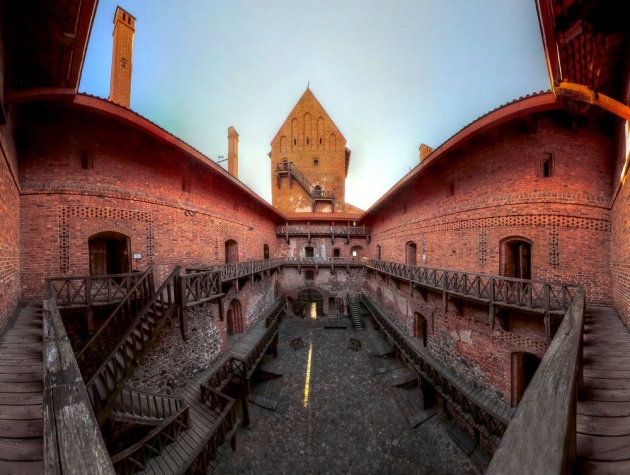
The inner courtyard of the Trakai Island Castle - Photo credit: efoto.lt
For those who love mysterious places and are interested in a history, it is necessary to travel to Trakai. The castle of Trakai is one of the most famous tourist attractions in Lithuania. The 300 m wooden bridge leading into the castle, the 12 km long canals, lakes, galleries, stained-glass windows, frescoes, secret transitions can enchant even those who are indifferent to the history. Currently, there is a Museum of History, there are often performed in the knights' tournaments, various concerts, and craft days.
I have been there a few times. It is the really enchanting place, so mysterious and beautiful, smelling the ancient life of dukes. There is only one disadvantage, that the castle gets too many visitors, you meet a lot of people in the territory of the castle. The museum itself was really interesting with a quite large and varied exposition, and authentic environment. Strolling around the castle, it is interesting to remember the Lithuanian history again. I really like the fact that the castle stands on the island, and you can admire the beautiful surroundings around the castle. Well, and Trakai itself is a beautiful town. The price to the museum is 6 euro to an adult man.
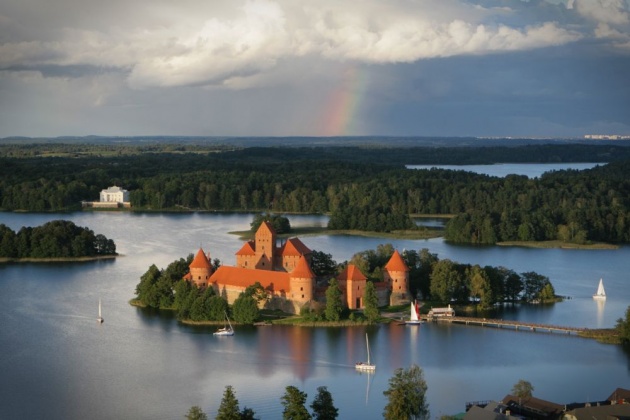
Trakai Island Castle - the castle of the Grand Duchy Of Lithuania - Photo credit: efoto.lt
Raudondvaris Castle
The current Raudondvaris Castle was built in 1653–1664 year. Before this time, there was another castle that was destroyed. During the uprising, the Russian army burnt down the castle, but it was rebuilt again. The main building of the Raudondvaris Castle is dated back to the XVII century. After many rebuildings, in 1944, Raudondvaris Castle was destroyed. In 1967-1975, the castle was restored.
In the spring-summer of 2012, greenery and flower beds were restored on the territory of the park. Currently, the Tourist Information Center, the Civil Marriage Palace, and the conference rooms are located there. Soon will be opened the Museum of Culture and Art. It is planned that the restaurant with halls for banquets will be opened soon in the orangery. Also, there is an Arts Incubator with a mobile theater and concert hall. There you can find the photographies and art gallery with exhibitions.
I have been there only one time with the school excursion. Actually, not much remember from this visit.
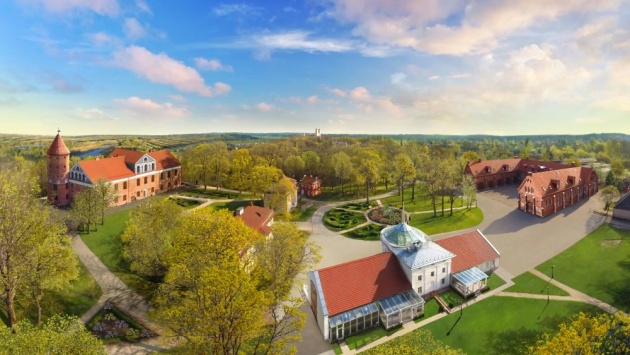
Raudondvaris Castle - photo credit: raudondvariodvaras.lt
Raudone castle
Raudone Castle is one of the most beautiful survived Lithuanian castles. Raudone means built from the red color's bricks. This castle was built in the 16th-century by Prussian merchant. Now, there is the main school of Raudone town. This brick-red castle's complex has maintained in the old "U" shape, an eclectic architectural style, and five towers, the most impressive of which is a cylindrical 33.5-meter high tower. From its summit, you can see a really spectacular panorama of the Nemunas River. Next to the castle is a park where you can see the linden tree with nine trunks, the ancient mill, which, thanks to the modern equipment of that age, was famous throughout the country.
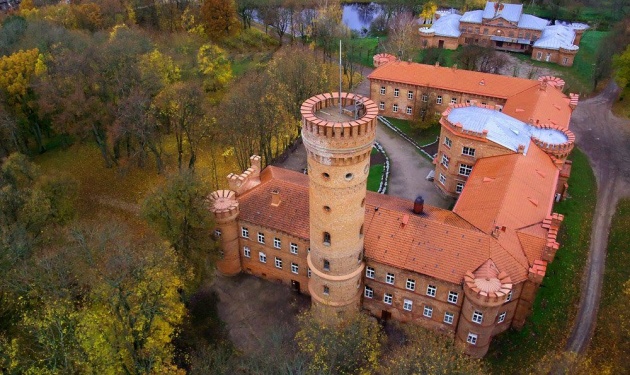
Raudone Castle - Photo credit: youtube.com
It is especially worthwhile to arrive here on May 25, when the theatrical festival takes place. It boasts craft yards, concerts, theatrical performances, and games. During the celebration, you can dress up in the historic costumes, sit on a chair or carriage, and take pictures, make jewelry yourself or try different delicacies.
I remember when first time visited this castle. I was may in a fifth or sixth grade. We had an excursion to some famous places in our country with my class by bus. We were too young to understand what the significant historical heritage it is. Later, after a few years, I already went there with my family, and that was a time when I really explored this castle.
Panemune castle
I like Panemune Castle very much. I cannot even say why because it is not so impressive and fully renovated as others, but it stays in such quiet place that I love walking around it. I feel such tranquility that is hard to describe. This castle I have visited a few times and will be happy to come back again and again.
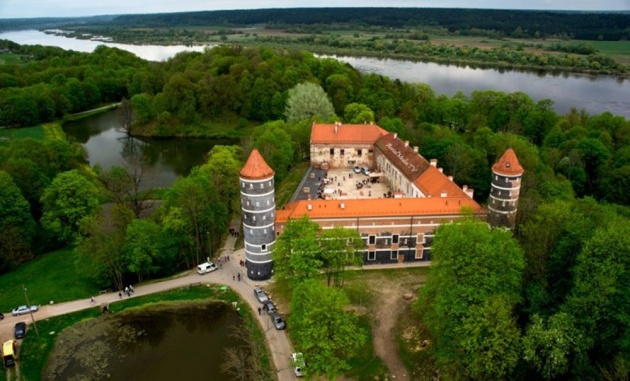
Panemune Castle - Photo credit: turistopasaulis.lt
The Panemune Castle is located on the right bank of the Nemunas slope. The spectacular castle building dates back to 1604-1610. This is a combined architecture of Renaissance and Gothic styles, supposedly created by architect Peter Nonhart. In 1935, the castle was given away to the Ministry of Education; now it is supervised by the Vilnius Academy of Fine Arts.
There is a park created in the seventeenth century near the castle, which previously consisted of flower beds, cascading ponds, were set up the water mills. Currently, only the park and cascade ponds have survived. Although the castle is being reconstructed, it is open for visitors. You can take a walk in the courtyards of the castle or enjoy the expanses of the Nemunas valley from the castle tower.
Medininkai Castle
The Medininkai Castle ruins of the Grand Duchy of Lithuania can be seen in Medininkai village. According to its purpose and design, the Medininkai Castle is considered the oldest castle in the Baltics. This castle was a more defensive tool than a building for the kings to live. In XIV-XV centuries, it was one of the largest defensive-type castles in the region, but after the Battle of Grunwald, it lost its strategic significance, and the residence of the dukes was established there.
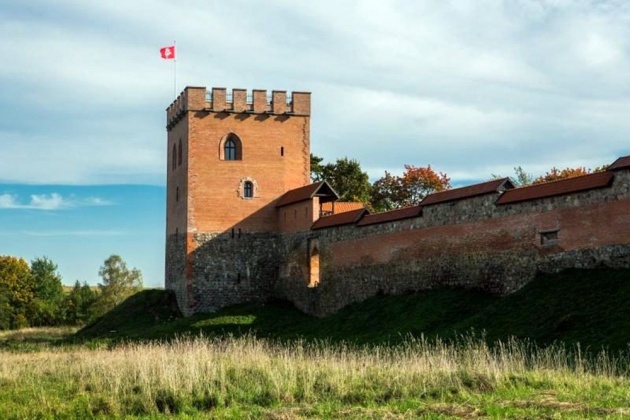
Medininkai Castle - Photo credit: klaipeda.diena.lt
The castle was ruined in the war with Russia in XVII century. The ruins once again were damaged in the Second World War. Now, there are remaining the 10-15 meters high wall, and the main tower of the castle - dungeon - was reconstructed in 2011. There is a museum built on each floor with exposition: masonry castles, archeological finds, warfare, silver items. On the fifth floor is the hall decorated with wall paintings for various events, and at the top of the tower opens the beautiful view of the surrounding area.
I can't say anything from my side as it is a shame, but I have not been there. It is located in the completely different side of Lithuania, too far away from the town where I live in. It ever happened to me to be in this part of the country, but I will surely visit it in one day.
Why we should value the history of our nation
The young men rarely think about the past of the nation. And if they do it, still, they rarely think about the importance of the history to the present. I have a different position. The history is significant because it is a starting point for our current actions. If we had not had such a past, we would not be such a nation as we are. After all, what has been appreciated to this day - the written sources, the struggle for freedom, the history - all that are the relics of the past closely related to what we seek and what we value today.
Without knowing what we were, we could make mistakes in our lives, and in the administration of the country.
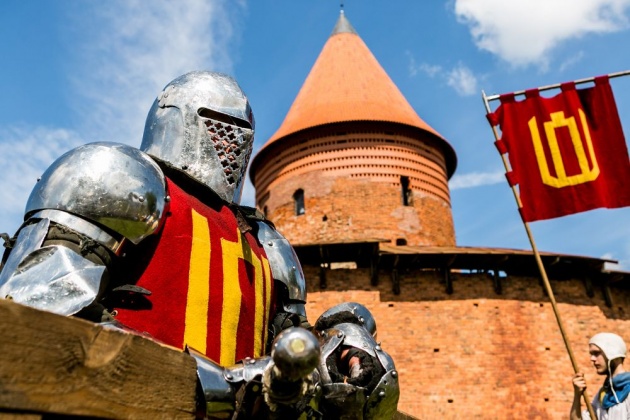
Knights Wrestling Tournament - Photo credit: etvatravel.eu
Another aspect of the history is the struggles of our ancestors for the state. If they would not fight for the state, perhaps we could be ruled by the strangers till now, we would not have an identity of our state, and, of course, would not have the freedom. At the present, we are getting strength from the great fights made by our compatriots, and it inspires us to strive for our state. After all, having inspirational examples, we can be strong not only in our country but also in the world - to fight for our language, culture, and country.
The history of the nation is like a guide star: it identifies mistakes and sets out the contours of a better life.
On the Final Note
Castles - the fortresses of rulers and noblemen of the past is a multidimensional phenomenon. This is great architectural monuments, historical witnesses, and a reflection of the warfare history. The castle is always an exclusive building of the concrete place, full of legends, attracting sightseeing and tourists.
The architects will write about castles in one way, the historians will write in other words, the archaeologists will notice one kind of things, and the military historians, art critics, folklore, tourist literature
authors - the completely different things. The naturalists will find something to say as well as the castle builders have used the natural barriers perfectly: hills, river valleys, rivers and streams, lakes, and swamps. All this made a castle inseparable part of the natural and cultural landscape.
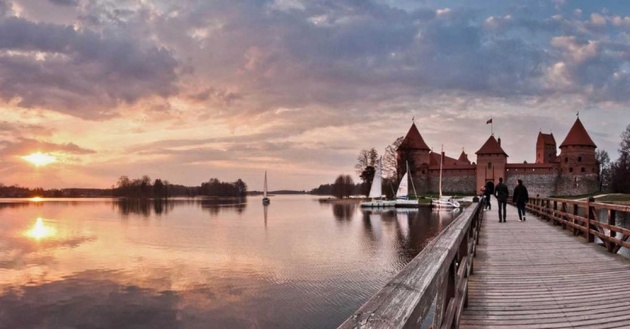
The bridge to the Trakai Island Castle - Photo credit: upsocl.com
In the end, the castle also is a pride and a symbol to many of our towns; not one castle of the Grand Duchy of Lithuania is portrayed in the towns' Coat of arms.
And what I can say about our castles, the simple citizen of the town which also has its own castle? I love the history of Lithuania, I love the history of my town, and for me, it is important that Lithuanian castles would survive and not be destroyed.
We need to understand how valuable and meaningful the castles are to us. The castles can become the symbols and witnesses of the past to us, to enrich, and to expand our horizons, and let to know the history.
A people without the knowledge of their past history, origin and culture is like a tree without roots. Marcus Garvey
Credit: brainyquote.com
***************************************************************************************************
Thank you for stopping by and reading my blog.
2018, All Rights Reserved.
You are very welcome to join Bitlanders and share your valuable knowledge and opinion.
***************************************************************************************************
You can check my other blog about Lithuania:
1. Easter Customs and Traditions in Lithuania
2. Traditional Lithuanian Cuisine in the Past and Now
3. A Visit to the SPA Center - Holiday Park
Come back to find more...
**************************************************************************************************



